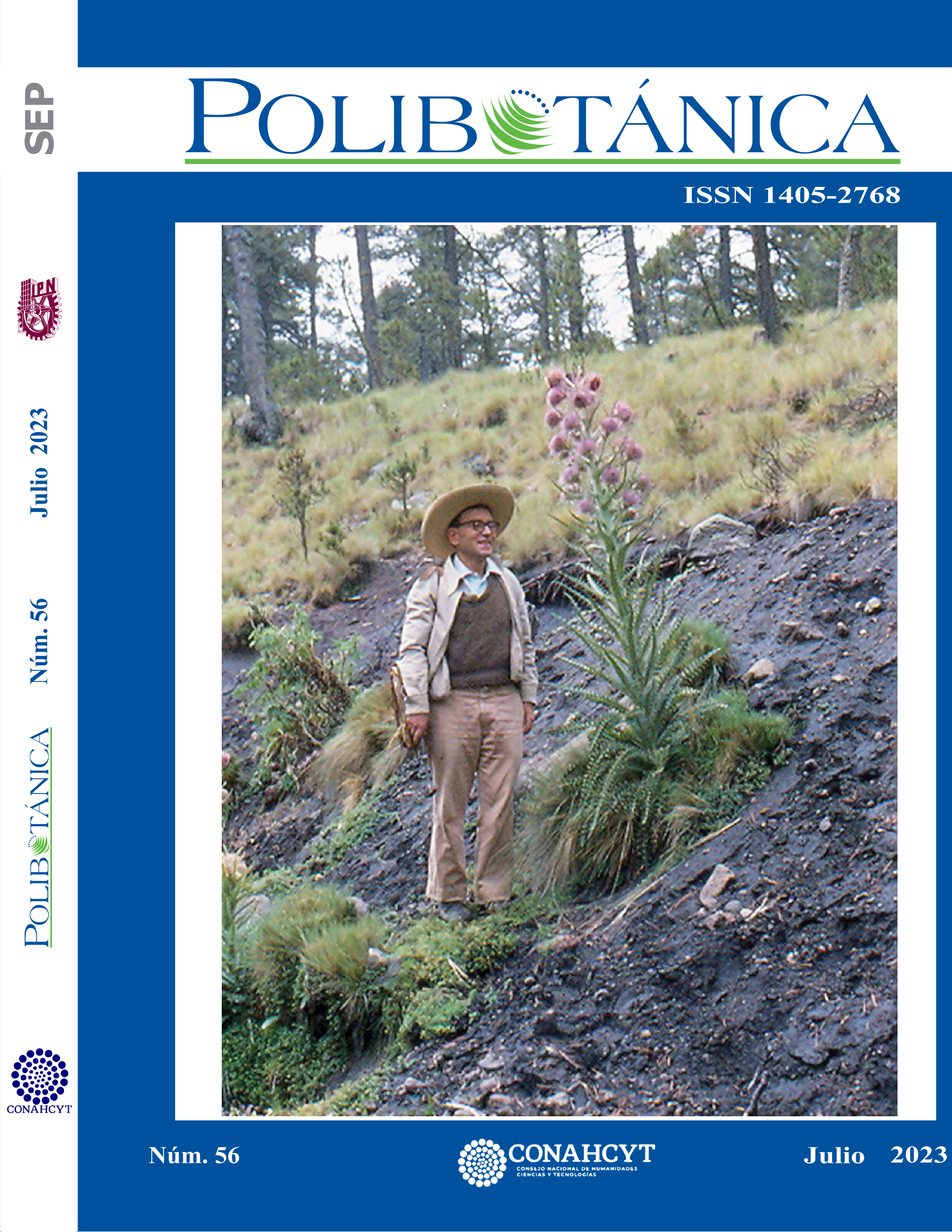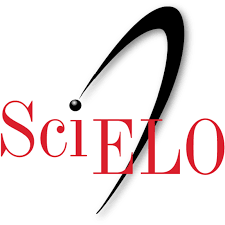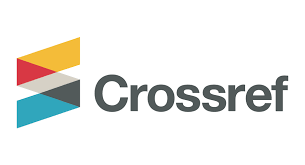Description and illustration of the morphogenic development of the young gametophytes and sporophytes of Asplenium blepharophorum bertol. (Aspleniaceae-Polypodiidae) in three natural substrates
DOI:
https://doi.org/10.18387/polibotanica.56.2Keywords:
apogamy, gametophytes, sexual dimorphism, gametangia, sporophytesAbstract
The development of the prothalus and the young sporophyte of Asplenium blepharophorum Bertol. are described. Studied material was collected in a cloud forest in San Antonio, 1 km north of Amecameca municipality, State of México. The spores were sown in glass vessel of 125 ml prepared in the following manner: the glasses were layered with ceramic, river stone, mosquito net and the three natural substrates: maquique, moss and plant litter, all previously sterilized and enclosed in plastic bag tied with copper wire. The cycle proved to be isosporeus with prothallial development corresponding to the Aspidium type. The gametophytes were only male and only female; in maquique only gametophyte female. The prothallus with sexual dimorphism, the male chordate with cauda and the female chordate with a large number of rhizoids and pads, the gametangia did not mature. Young sporophytes were apogamous obtained around 351 days after sowing in maquique, 356 in moss and the plant litter 473. The possibility that it is a hybrid or polyploid entity is discussed.
References
Arreguín-Sánchez, M. L., Fernández-Nava, R. y Quiroz-García D. L. (2004). Pteridoflora del Valle de México. Instituto Politécnico Nacional.
Ballesteros-Montiel. B. J., Arreguín-Sánchez, M. L., Fernández-Nava, R y Quiroz-García, D. L. (2019). Descripción del desarrollo morfogénico de los prótalos y esporófitos jóvenes de Pteris quadriaurita Retz (Pteridaceae-Polypodiidae) en tres soportes naturales. Polibotánica 48:65-80.
Bell, P. (1992). Apospory and apogamy: implications for understanding the plant life cycle. International J. Plant Sci. 153 (3): S126-S136.
Christenhusz, M.J.M., X. Chun Z. y H. Schneider. (2011). A linear sequence of extant families and genera of lycophytes and ferns. Phytotaxa, 19: 7-54.
Crist, K. C. y D. R. Farrar. (1983). Genetic load and long-distances dispersal in Asplenium platyneuron. Canad. J. Bot. 61:1809-1814.
Dong, S. (2011). Taxonomic studies on Asplenium sect. Thamnopteris (Aspleniaceae) I: Cytological observations. Amer. Fern J. 101(3): 156-171.
Estrelles, E. e Ibars, A. M. (2017). Protocolo de germinación de esporas y caracterización del desarrollo de los gametofitos de Asplenium majoricum Litard. (Aspleniaceae). Botanic asPPECTS nº 3.1
http://jardibotanic.org/fotos/pdf/publicacion_107_TS3.1_Asplenium_majoricum.pdf
Gastony, G. J. (1970). Asplenium pinnatifidum X trichoma, es. A new record for Indiara. Amer. Fern J. 81 (71): 32-33.
Gastony, G. J. y Johnson, W. P. (2001). Phylogenetic placements of Loxoscaphe thecifera (Aspleniaceae) and Actinopteris radiata (Pteridaceae) based on analysis of rbcL nucleotide
sequences. American Fern Journal 91: 197-213.
Giudice, G. E., Luna, M. L. y Ganem, M. A. (2013). El género Hymenasplenium
(Aspleniaceae) en Argentina. Darwiniana nueva serie 1(1):46-53.
Haufler, C. H. (2013). Species and speciation (pp. 303-331). En : Ranker, T. A. and Haufler, C. H. (eds.). Biology and Evolution of Ferns and Lycophytes. Cambridge University Press, United Kingdom.
Herrero, A., Prada, C., Pangija, E., Escudero, S., Rublo, A. y Pajaron, S. (1993). Gametophyte morphology of four subspecies of Asplenium trichomanes L. 1993. Botánica Complutensis 18: 67-77.
Huang, Y.-M., Chou, H. M., Hsieh, T. H., Wang, J. C., & Chiou, L. C. (2006). Cryptic characteristics distinguish diploid and triploid varieties of Pteris fauriei (Pteridaceae). Can. J. Bot. (84), 261-268.
Huang, Y-M., Hsu, S-Y., Hsieh T-H., Chou H-M., y Chiou W-L. 2011. Three Pteris species (Pteridaceae: Pteridophyta) reproduce by apogamy. Botanical Studies 52: 79-87.
Hunt, H. V., Ansell, S. W., Russell, S. J., Schneider, H. y Vogel, J. C. 2011. Dynamics of polyploid formation and establishment in the allotetraploid rock fern Asplenium majoricum. Annals of Botany 108: 143–157.
Lavalle, M. C. y Prada, C. (2007). Morfología del esporófito y el gametófito de Asplenium dareoides (Aspleniaceae, Pteridophyta). Darwiniana 45(1): 13-22.
Martínez, O. G. (2010). Gametófitos y esporófitos jóvenes de cuatro especies de helechos del género Pteris (Pteridaceae) naturalizadas en América. Rev. Biol. Trop. 8 (1): 89-102.
Maxon W. R. (1908). Studies of tropical American ferns-No. 1. Asplenium salifolium and and confused species. Contr. U. S. Natl. Herb. 10: 473-508. https://www.jstor.org/stable/23491542
Maxon W. R. (1913). Studies of tropical American ferns-No. 4. Asplenium trichomanes and its allies. Contr. U. S. Natl. Herb. 17: 134-153.
Mickel, J. T. y A. Smith. (2004). The Pteridophytes of Mexico. Memoirs of the New York Botanical Garden. 88: 72-132.
Montoya-Casimiro. M. C., Álvarez-Varela, R., Pérez-Hérnandez, S. y Arreguín-Sanchez, M. L. (2000). Ciclos biológicos de Blechnum occidentale L. var. occidentale (Blechnaceae-Pteridophyta) y Thelypteris resinífera (Desv.) Proctor (Thelypteridaceae-Pteridophyta). An. Esc. Nac. Cienc. boil., México. 46(3): 317-339.
Moran, R. C. (1995). Aspleniaceae. Moran, R. C. y R. Riba (Eds.) “Psilotaceae a Salviniaceae”. In: G. Davidse, M. Sousa y S. Knapp (Eds. Grales). Flora mesoamericana. Instituto de Biología, Universidad Nacional Autónoma de México-Missouri; Botanical Garden- The Natural Histiry Museum (Londres), México, D.F. 1:290-298.
Morlang, C. (1967). Hybridization, polyploidy and adventitious growth in the genus Asplenium. Amer. J. Bot. 54: 887-897.
Morzeti, V. M. (1966). Morphological and cytological data on Southeastern United States species of the Aspleniumheterochroum-resiliens complex. Amer. Fern J. 56:167-176.
Mucciflora, S. y P. Gori. (1995). Asplenium trichomanes spp. trichomanes Gametophyte. A light and electron microscope study. Caryologia. 48(3-4): 265-274.
Murakami, N., y Schaal, B.A. (1994). Variación del ADN del cloroplasto y la filogenia de Asplenium sect. Hymenasplenium (Aspleniaceae) en los trópicos del Nuevo Mundo. Revista de Investigación de Plantas , 107 (3), 245-251.
Murakami, N. (1995). Systematics and evolutionary biology of the fern genus Hymenasplenium (Aspleniaceae). Journal of Plant Research 108: 257-268.
Murakami, N., Nogami, S., Watanabe, M. y Iwatsuki, (1999). Phylogeny of Aspleniaceae inferred fron rbcL nucleotide sequences. Amer. Fern. J. 89 (4):232-243.
Nayar, B. K. y S. Kaur. (1969). Types of prothallial development in homosporous ferns. Phytomorphology. 19(2): 179-188.
Nayar, B. K. y S. Kaur. (1971). Gametophytes of Homosporous Ferns. Bot. Rev. 37(3): 295-396.
Pérez, C. F. J. y Fernández A. M. P. (1992). Asplenium petrarchae nothosubsp. diazii (Aspleniaceae, Pteridophyta), un híbrido natural nuevo para la flora levantina y precisiones sobre sus progenitores. Anales Jard. Bot. Madrid 50(1): 15-25.
Pérez, C. F. J. y Fernández, A. M. P. (1996. Híbridos del género Asplenium L. (Aspleniaceae) en la Península Iberica. Anales Jardín Botánico de Madrid 54:106-125.
Pangua, E., Prada, C., Pajarón, S. y Salvo, E. (1992). Un nuevo híbrido de Asplenium de Valencia (España) relacionado con A. majoricum Litard. Botanical Journal of the Linnean Society 108: (1) 1-13. https://doi.org/10.1111/j.1095-8339.1992.tb00232.x
Prada, C., Pangua, E., Pajarón, S., Herrero, A., Escudero, A. y Rubio, A. (1995). A comparative study of gametophyte morphology, gametangial ontogeny and sex expression in the Asplenium adiantum-nigrum complex (Aspleniaceae, Pteridophyta). Ann. Bot. Fern. 32: 107-115.
Raghavan, V. (1965). Action of purine and pyrimidine analogs on the growth and differentiation of the gametophytes of the fern Asplenium nidus. Amer. J. Bot. 52: 900-910.
Raghavan, V. y Tung H. F. (1967). Inhibition of two-dimensional growth and suppression of ribonucleic acid and protein synthesis in the gametophytes or the fern, Asplenium nidus, by chloramphenicol, puromycin and actinomycin D. Amer. J. Bot. 54(2): 198-204.
Raghavan, V. (1969). Interaction of light quality and nucleases in the growth of the gametophytes of Asplenium nidus. Amer. J. Bot. 56: 871-879.
Regalado G. L., Prada, C. y Gabriel y Galán, J. M, (2010). Sexualidad y apogamia en el complejo Asplenium auritum cubano–monodon (Aspleniaceae). Plant Syst Evol 289, 137–146. https://doi.org/10.1007/s00606-010-0339-5.
Regalado, L. R. y C. Prada (2011). The genus Hymenasplenium (Aspleniaceae) in Cuba, including new combinations for the neotropical species. American Fern Journal 101: 265-281.
Salazar-Aguilar, S., Arreguín-Sánchez, M. L., & Tejero-Díez, J. D. (2015). Descripción del desarrollo del prótalo de tres especies cortícolas (Polypodium colpodes Kunze, Polypodium arcanum Maxon var. bakerii (Daven.) Mickel et Tejero y Phlebodium inaequale T. Moore (Polypodiaceae-Polypodiophyta. Polibotanica 39: 21-48
Sánchez-Montiel, L., Arreguín-Sánchez M. L y Fernández-Nava, R. (2008). Gametofitos y esporofitos jóvenes de dos Pteridophitas: Asplenium monanthes L. (Aspleniaceae-Pteridophyta) y Elaphoglossum minutum (Pohl ex Fée) T. Moore (Lomariopsidaceae-Pteidophyta). Polibotánica 25: 29-43.
Schneider, H.; S. J. Russell, C. J. Cox, F. Bakker, S. Henderson, F. Rumsey, J. Barrett, M. Gibby & G. C. Vogel. 2004. Chloroplast phylogeny of Asplenioid ferns based on rbcL and trnL-F spacer sequences (Polypodiidae, Aspleniaceae) and its implications for biogeography. Systematic Botany 29: 260-274.
Sheffield, E. (2013). Alternation of generations. pp 49-74. En: Ranker, T. A. and Haufler, C. H. (eds.). Biology and Evolution of Ferns and Lycophytes. Cambridge University Press, United Kingdom.
Testo, W. L. y Watkins, E. (2013). Understanding mechanisms of rarity in pteridophytes: Competition and climate change threaten the rare fern Asplenium scolopendrium var. americanum (Aspleniaceae). Comparative development and gametophyte morphology of the hart’s-tongue fern, Asplenium scolopendrium L. American J. Bot. 100(11):2261-2270.
Tryon, R. M y Tryon, A. F. (1982). Ferns and Allied Planths with Special Reference to Tropical America. Springer-Verlag, New York.
Tryon, A. F. y Lugardon, B. (1991). Spores of the Pteridophyta. Springer-Verlag, New York.
Van den Heede, S., Pajarón, S., Pangua, E. y Viane, R. L. L. (2004). Asplenium ceterach and A. octoploideum on the Canary Islands (Aspleniaceae, Pteridophyta). Amer. Fern J. 94 (2): 81-111.
Walker, T.G. 1962. Cytology and evolution in the fern genus Pteris L. Evolution 16: 27-43.
Weatherby, C. A. (1931). Asplenium fragile group. Contr. Gray Herb. Harv. Univ. 95:52.
Downloads
Published
Issue
Section
License

Polibotánica by Departamento de Botánica de la Escuela Nacional de Ciencias Biológicas del Instituto Politécnico Nacional se distribuye bajo una Licencia Creative Commons Atribución-NoComercial-CompartirIgual 4.0 Internacional.




















